

Xml - Usage of XSLT Params; <xsl:param> & <xsl:with-param> How to avoid all namespace occurrence in output by writing a single statement in XSLT. Xslt - How to copy all child nodes of any type of a template context element. XSLT 2.0 flexible with default or different prefixed namespace of the same URI. Requirements and Use Cases for XSLT 3.0. 2 Requirements 2.1 Enabling Streamable Processing XSLT should provide some facilities to enable transformation of a source document on the fly without constructing a complete tree representation of the document in memory.
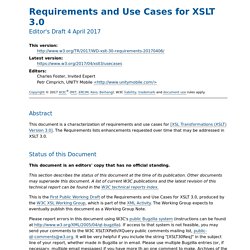
Difficulties with transformations when the entire document cannot fit into memory or when results must be produced while reading the input are the main motivation for this requirement. The streaming facilities can impose constraints on stylesheets to ensure that streamable processing is possible. There must be a way to determine if a construct is streamable and whether the processor can guarantee that it will be processed using streaming. To facilitate the analysis of streamability, new explicit constructs for some typical tasks may be added to the language. Xslt - XSL - copy elements but remove unused namespace(s) Getting Value from XSL Parameters. Kurt Cagle June 22, 2000 Contents Understanding XSLT Parameters and VariablesA Select VintageSetting ParametersSummary If you have ever written an ASP page, you've probably engaged in two activities: reading information from some external resource and saving other (generally modified) information to some other resource, which has only incidental importance to the ultimate output that gets sent to the client.
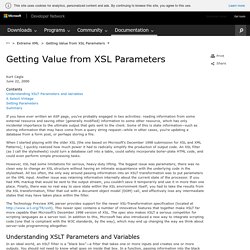
Some of this is state information—such as storing information that may have come from a query string request—while in other cases, you're updating a database from a form post, or perhaps storing a file. When I started playing with the older XSL (the one based on Microsoft's December 1998 submission for XSL and XML Patterns), I quickly realized how much power it had to radically simplify the production of output code. However, XSL had some limitations for serious, heavy-duty lifting. Digital humanities. What is new in XSLT 3.0. New instructions and declarations Along with all XSLT 1.0 and XSLT 2.0 constructs, the following constructs are new in XSLT 3.0 and are fully supported: <xsl:package> can be used to declare a package manifest or as alternative for a more type-safe stylesheet with declared-modes.

<xsl:use-package> is the equivalent of import or use in other programming languages and takes a name and version of a (precompiled) package. After using a package, you can choose to accept with <xsl:accept> what parts you want to use, or simply use all components. <xsl:override> is the XSLT instruction to override used components, similar, but not the same as overriding inherited members in object-oriented languages. New or enhanced attributes Summary of several attributes that have been added to existing elements, or have come available to all elements in XSLT 3.0:
Remove XML default namespace from root using XSLT. My XSLT Toolbox – copy and copy-of « Eddie Welker.com. December 27, 2008 Posted by Eddie Using XSLT to copy elements is extremely common when you’re transforming a source document of a certain type (XML, HTML, etc.) to the same type.
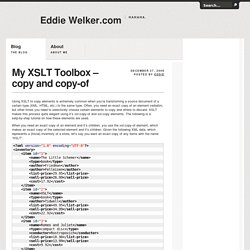
Often, you need an exact copy of an element verbatim, but other times you need to selectively choose certain elements to copy and others to discard. Improve your XSLT 2.0 stylesheets with types and schemas. Specify schema types, parameters types, and return values with XSLT 2.0 for easier debugging and maintenance Priscilla WalmsleyPublished on May 15, 2012.
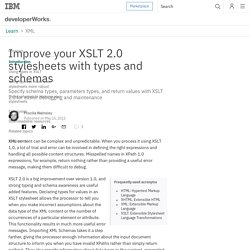
Attribute value templates (AVT) What is new in XSLT 3.0. What is new in XSLT 3.0. Introduction to XSLT 3.0. While many W3C specifications take years to reach the recommendation state, XSLT has evolved quickly and deterministically, thanks not in small part to the great talent and sobriety of its spec. chair and a dedicated board committee.

The Stylus Studio team decided to be on the cutting edge, introducing support for the current XSLT 3.0 working draft in version X14 in order to give a chance to the community to start developing using the new language edition. A variety of exciting new features have been introduced to make the language modern and to allow implementers to take advantage of modern hardware for transforming large data sets. Support for Streaming The need to process XML in streaming fashion, in other words, without loading the entire input document in memory, has risen over the years. Several use cases require processing very large streams of XML events, for example stocking tickers or social media user's stream.
Here I show the specification formally defines streaming: <? <? ... XSLT 3.0 - new features. Improve your XSLT 2.0 stylesheets with types and schemas. Can't stop thinking about XSLT in procedural terms... help with apply-templates. MicroHOWTO: List of microHOWTOs. Using XSLT to copy all nodes in XML, with support for special cases. How XSLT Works — Lenz Consulting Group, Inc. By Evan Lenz This is Chapter 3 from XSLT 1.0 Pocket Reference.
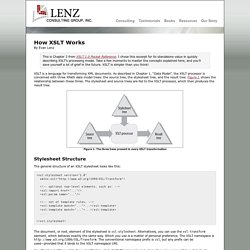
I chose this excerpt for its standalone value in quickly describing XSLT’s processing model. Take a few moments to master the concepts explained here, and you’ll save yourself a lot of grief in the future. XSLT How To's. Xsl:namespace in XSLT 2.0. RE: [xsl] insert a tab/space characters. Concatenation - XSLT concat string, remove last comma. The Extensible Stylesheet Language Family (XSL) XSLT Chapter 8: Advanced Pattern Matching. XSLT. XSLT (Extensible Stylesheet Language Transformations) is a language for transforming XML documents into other XML documents,[1] or other objects such as HTML for web pages, plain text or into XSL Formatting Objects which can then be converted to PDF, PostScript and PNG.[2] The original document is not changed; rather, a new document is created based on the content of an existing one.[3] Typically, input documents are XML files, but anything from which the processor can build an XQuery and XPath Data Model can be used, for example relational database tables, or geographical information systems.[1] XSLT is a Turing-complete language, meaning it can specify any computation that can be performed by a computer.[4][5] History[edit] Design and processing model[edit] Diagram of the basic elements and process flow of Extensible Stylesheet Language Transformations.
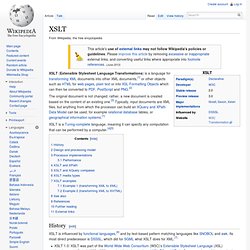
Processor implementations[edit] Performance[edit] Installing an XSLT processor. This section describes how to install the free processors.

The commercial processors are assumed to provide instructions and support. You should check the details with each product that is described here, as the steps may change over time. The installation of xsltproc is platform dependent since it is a compiled C program. You will need a C compiler and associated Make tools unless you are using Windows. Macintosh users can download binaries from Installing xsltproc on Windows You can download precompiled versions for Windows from Igor Zlatkovic's website: XSLT basics. Maintained by: David J.

Birnbaum (djbpitt@pitt.edu) Last modified: 2014-02-12T14:45:01+0000. Comparing XSLT 1.0 and XSLT 2.0. Undefined Comparing XSLT 1.0 and XSLT 2.0 In this article, I shall compare the XSLT 1.0 and XSLT 2.0 programming languages. I have seen the XSLT language evolving from version 1.0 to 2.0, therefore I find it quite interesting to compare the two language versions. How old are these two languages, and a little bit of history? XSLT 1.0 became the W3C Recommendation on 16 November 1999. XSL Transformations (XSLT) Version 2.0. XQuery 1.0 and XPath 2.0 Functions and Operators (Second Edition) See [Working With Timezones] for a disquisition on working with date and time values with and without timezones. 10.1 Duration, Date and Time Types The operators described in this section are defined on the following date and time types:
XQuery 1.0 and XPath 2.0 Data Model (XDM) (Second Edition) This section describes the constraints on instances of the data model. This document describes how to construct an instance of the data model from an infoset ([Infoset]) or a Post Schema Validation Infoset (PSVI), the augmented infoset produced by an XML Schema validation episode. An instance of the data model can also be constructed directly through application APIs, or from non-XML sources such as relational tables in a database.
Regardless of how an instance of the data model is constructed, every node and atomic value in the data model must have a typed-value that is consistent with its type. The data model supports some kinds of values that are not supported by [Infoset]. Examples of these are document fragments and sequences of Document Nodes. 3.3 Construction from a PSVI An instance of the data model can be constructed from a PSVI, whose element and attribute information items have been strictly assessed, laxly assessed, or have not been assessed.
XSL Transformations (XSLT) Version 3.0. Saxon Running XSLT from the Command Line. A command is available to apply a given stylesheet to a given source XML document. For simple transformations on the Java platform, use the command: java net.sf.saxon.Transform -s:source -xsl:stylesheet -o:output where source, stylesheet, and output are the source XML file, the XSLT stylesheet,B and the output file respectively. For the .NET platform, the command is simply: Re: [xsl] replacing nodes during xsl:copy-of. Namespaces in XSLT — Lenz Consulting Group, Inc. By Evan Lenz.